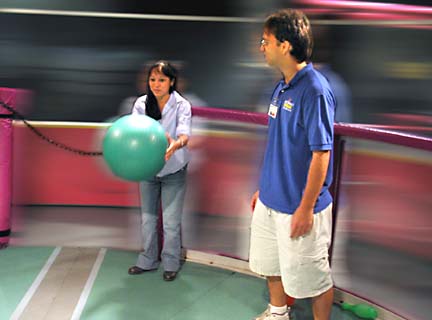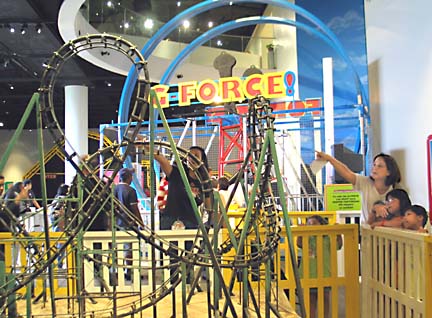
You may feel like the bridge is turning as you walk along it, but the walls are actually rotating around you.
Physics for
the fearlessCoaster display is dazzling
Scream Machines: The Science of Roller Coasters
Where: Bishop Museum Castle Building, 1525 Bernice St.When: Open 9 a.m. to 5 p.m. daily through Aug. 29
Admission: $14.95 general; $11.95 for 65 and older and ages 4 to 12; free for 3 and under, and museum members; discounts available for residents with ID
Call: 847-3511
There aren't many modes of transport that demonstrate the laws of physics as thoroughly as roller coasters -- but then, a smooth ride isn't exactly the point.
After all, the classic roller coaster is unpowered, relying on speed and mass and momentum to carry the cars around the track, which in turn offers little lessons in centrifugal force, Coriolis effects and the delicate mechanisms of the inner ear.
Gravity -- it's not just a good idea, it's the law.
In his book "The Evolution of Physics," the always amusing Albert Einstein pointed out that roller coasters are Exhibit A in a model of energy conservation in a mechanical system. Potential energy is converted to kinetic energy, thanks to gravity and momentum.
Participants can bicycle to loop-the-loop on the G-FORCE.From riding blocks of ice downhill in 15th-century Russia to Pennsylvania coal miners discovering that the Mauch Chunk coal railway could hit 100 mph while flying downhill -- in 1827! -- to today's scientifically engineered super roller coasters, the ride has struck a nerve.
Nearly 300 million rides occur a year in the nation's amusement parks. Why, if that many people visited science museums ...
"Scream Machines -- The Science of Roller Coasters" is one of Carnegie Science Center's latest touring crowd pleasers and has recently been bolted together in Bishop Museum's exhibit hall. The pride of place is given to a bicycle-powered, loop-the-loop contraption called "G-FORCE" -- strap yourself in, pedal like crazy, and your bicycle will go around and around while a camera records your face sweating and contorting. (Great for first dates.)
Roller coasters also operate through sensation, both acting on our nerve stimuli and our programmed frights. Really, you're not likely to go flying off into space as the roller coaster starts going. It just feels like it. All those tight turns and outside loops are built into the roller coaster deliberately to increase the sensation -- and also to bleed off speed.
Kathy Izon and Leon Geschwind demonstrate the Revolver, a rotating platform that spins just fast enough that you can't walk in a straight line or roll a ball.
Add to that our acquired knowledge of what happens to objects that are speeding through space. They go out of control and whack into things. Yikes. But roller coasters feed on that fear, even though they're pretty safe machines. (Try reminding yourself of that next time you ride one.)
The first thing you see approaching the exhibit's Tumble-Vision display is a picture of a fellow looking queasy, warning patrons that they might get disoriented, that is to say, barf-y.
Maybe a local airline could donate air-sickness bags to the exhibit?
"We asked," laughed the museum's Kathy Izon, who gamely tried every exhibit for us. "But it seems they didn't have any to spare."
She walked right into Tumble-Vision, keeping her eyes on the floor, and for good reason. It's essentially a stationary bridge surrounded by rotating spots of light, like a disco from hell. All of your senses tell you the bridge is swinging out of control.
Bishop Museum has a new exhibit on display. Check out what makes roller coasters go.
Another eye-opener is the Revolver, a rotating platform that spins just slow enough to walk about easily, and just fast enough to note that you can't walk in a straight line. Bishop Museum science educator Leon Geschwind demonstrated by rolling a beachball -- wait, that ball is arcing off to the side!
Give it some English to correct -- still isn't easy. The Coriolis effect causes side forces. As Geschwind points out, try this in three dimensions and you have some clue as to why it isn't easy to launch probes to other planets.
"Launch window?" Just rolling a ball across the floor is impossible when the rules of physics don't play nice.
Bishop Museum
www.bishopmuseum.org
Click for online
calendars and events.




